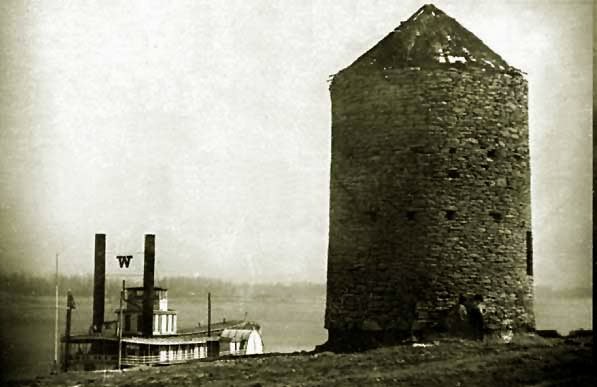
The sidewheel packet Wyoming moored near the old
Spanish Fort, St. Louis, Missouri, early 1850's,
St. Louis. The fort was razed in 1856.
In addition to "blue water"ships which carried emigrants across the Atlantic, there were severa;
steamboats which carried which carried freight and passengers on western rivers. Among them was the sidewheel packet
Wyoming constructed in 1846 in Jacksonville, Pennyslvania. She burned at Pekin, Illinois on December 16, 1853.
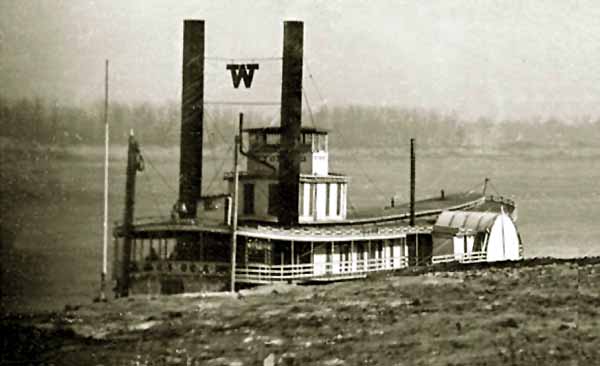
Close up, the sidewheel packet Wyoming moored St. Louis, Missouri, early 1850's
St. Louis.
Subsequently there was a sternwheeler operated by Coulson & Company of Yankton, Dakota Territory.
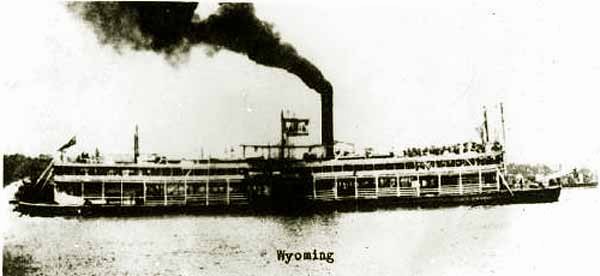
Upper Missouri River Steamer Wyoming, approx. 1880's
The vessel constructed in 1879 in Pittsburgh was a sister to the Montana and
the Dacotah. Each were 250 feet long. They were regarded as the "leviathans of the Plains."
Coulson & Company was also the owner of the Far West used in Col. Custer's ill-fated Campaign of 1876.
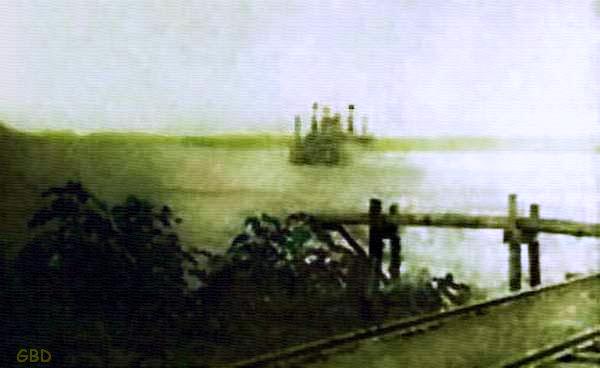
The Sternwheel Steamboat Wyoming Leaving the Landing at
Missouri City, Missouri.
The vessel was later sold to the Lineham Transit Company and used as a car carrier (trains) between Brooklyn, Ill. and
Paducah. In 1892 she was renamed the "George W. Parker and sold to the Leavenworth Coal Company to carry coal from
Leavenworth to Kansas City and renamed the . In 1896 she was being used to pummp sand from the
Missouri River and she was stranded with a shift of the River and was abandoned.
Additionally, on the Great Lakes were a number of vessels named Wyoming, There was a steam barge constructed in
East Saginaw in 1871. She was, however, short lived, sinking in July 1871. Another was a steam paddle wheeler whose
home port was Detroit. Others included a sail schooner constructed in 1870 and converted to steam in 1891 and another owned by the Port Huron & Duluth Steamship Co.
A propeller steamer constructed in 1887 and sailing between Port Huron and the head of Lake Superior was owned by the Lake Michigan & Lake Superior Transportation Co. of Chicago.
A 241 foot long wooden hulled bulk grain steamer was owned by P & H. Ltd. of Mississaugua, Ontario. Its name was changed to the Mapleglen and was ultimately
scuttled near Kingston, Ont., in 1925.
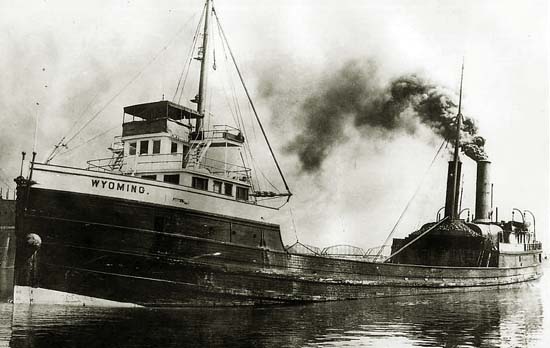
The Great Lakes Steamer Wyoming
One of those Great Lake steamers is remembered in a snippet of
a Great Lakes song, in apparent structure a capstan or heaving shanty, the melody of which has been lost in time. Thus, the
background music for the page is another heaving shanty, "Blow the Man Down."
|
THE STEAMER WYOMING
Come all ye jolly seamen,
Now as it's getting late
And I'll sing you my experience
On a bad package freight.
It was on the steamer Wyoming,
And it almost proved my ruin;
I cursed the day I saled away
From the city of Port Huron.
The captain was the meanest man
That ever trod a plank;
The first mate was a son-of-a-gun,
And the second mate a crank.
The wheelsmen, they were jolly,
And the watchman ful of fun;
The deckhands, they were hoboes,
And the firemen, they were bums. |
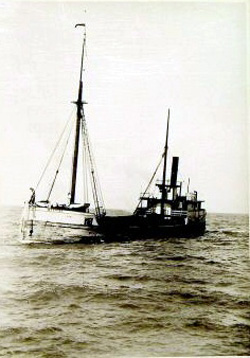
Great Lakes Steamer Wyoming |
The present USS Wyoming, on the previous page, may not, however,
be the last. The television program Star Trek has predicted the existence of a USS Wyoming in space,
just as Capt. Cook's HMS Endeavour finds its counterpart in the space shuttle program. Pictured below
is the Mediterranean Class Starship of which the Starship USS Wyoming mentioned in the episode
Flashback, will be a part in the 24th Century.

United Federation of Planets USS Wyoming, NCC-43730
Music this page:
BLOW THE MAN DOWN
Come all ye young fellows that follow the sea,
to my way haye, blow the man down,
And pray pay attention and listen to me,
Give me some time to blow the man down.
I'm a deep water sailor just in from Hong Kong,
to my way haye, blow the man down,
if you'll give me some grog, I'll sing you a song,
Give me some time to blow the man down.
'Twas on a Black Baller I first served my time,
to my way haye, blow the man down,
And on that Black Baller I wasted my prime,
Give me some time to blow the man down.
'Tis when a Black Baller's preparing for sea
to my way haye, blow the man down,
You'd split your sides laughing at the sights that you see.
Give me some time to blow the man down.
With the tinkers and tailors and soljers and all
to my way haye, blow the man down,
That ship for prime seaman on board a Black Ball.
Give me some time to blow the man down.
'Tis when a Black Baller is clear of the land,
to my way haye, blow the man down,
Our Boatswain then gives us the word of command
Give me some time to blow the man down.
"Lay aft," is the cry,"to the break of the Poop!
to my way haye, blow the man down,
Or I'll help you along with the toe of my boot!"
Give me some time to blow the man down.
'Tis larboard and starboard on the deck you will sprawl,
to my way haye, blow the man down,
For "Kicking Jack" Williams commands the Black Ball.
Give me some time to blow the man down.
Pay attention to order, now you one and all,
to my way haye, blow the man down,
For right there above you flies the Black Ball.
Give me some time to blow the man down.
|
Writer's notes: The Black Ball line was an early transatlantic line founded in 1817 by Philadelphia Quakers Jeremiah Thompson, Isaac Wright and Bejamin Marshall.
The Black Ball Line also ran monthly clipper packets from the East India Docks in London to
Queensland. One of the line's infamous clippers was the Queen of the Colonies. The Reverend T. P. Boland later described the ship as:
...the Queen of the Colonies was a notorious hell-ship of those days of man-killing captains
and bucko mates. Some 17 crew off the Queen of the Colonies were imprisoned aboard
the floating jail house, the Julia Percy in 1863 for playing up while at sea...and
crews were paid-off on arrival at Moreton Bay and fresh crews were
engaged to take the ship home...The Queensland Immigration Society, 'Journal of the Royal Historical Society of Queensland', Vol. 7, No. 2, 1914.
The ship had two encounters with the pride of the Confederate Navy, the CSS Alabama. In one
instance the Queen of the Colonies was able to escape to the protection of the
Thames estuary. In the other, Captain Raphael Semmes, Confederate States Navy, apparently declined to sink or board her in light of the vessel hoisting the
Union Jack. Many American vessels transferred to British registry at the time of the Civil War in order to
escape capture or sinking by the Confederate Navy.
The Queen of the Colonies was lost near Brest in January 1875 when in a storm she was
blown into some rocks.
"Kicking Jack" Williams was master of the Clipper Ship Andrew Jackson which sailed from
New York to the mouth of San Francisco Harbor in 89 days 4 hours and was, thus, advertised as the
"fastest ship in the World."
 This chapter suggested by fellow lodge brother, Mike L.,
This chapter suggested by fellow lodge brother, Mike L.,
father of a former member of the Boat's Company, USS Wyoming.
Bro. Mike for some unknown reason always wears green.
Next page: The schooners Wyoming , Governor BrooksWashakie.
|